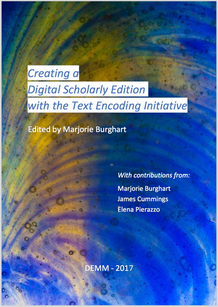Digital Scholarly Editions: Manuscripts, Texts and TEI Encoding
Do you want to create a digital scholarly edition? Then this course is for you! Here you will learn to master the technologies of XML, the Text Encoding Initiative (TEI), and XSLT to produce great digital editions. You will learn to create critical editions, facsimile editions and useful visualizations of your editions.
There are no prerequisites for this course. It will start with the basics of XML and the TEI, and will move slowly to more advanced features, such as indexes. The videos are recorded in English, but subtitles are available in French and Italian. The course is divided into four main units, and two optional units:
The two optional modules will introduce you to image annotations for facsimile editions, and XSLT transformations (a language that will help you analyze and visualize your data). Before you start, do not forget to download the course material!
If you are not convinced yet, have a look at these wonderful examples of digital editions on the web:
These editions have all one thing in common: they have been created with the TEI, and this is what you are going to learn in this course.
 As a companion to this course, we recommend the freely available ebook Creating a Digital Scholarly Edition with the TEI (PDF)
As a companion to this course, we recommend the freely available ebook Creating a Digital Scholarly Edition with the TEI (PDF)
There are no prerequisites for this course. It will start with the basics of XML and the TEI, and will move slowly to more advanced features, such as indexes. The videos are recorded in English, but subtitles are available in French and Italian. The course is divided into four main units, and two optional units:
- Introduction to XML and the TEI
- Manuscript Transcription
- Critical editions and their encoding in TEI
- Advanced features: indexes, names and dates
- Annotating Images (Optional)
- XSLT Transformations (Optional)
The two optional modules will introduce you to image annotations for facsimile editions, and XSLT transformations (a language that will help you analyze and visualize your data). Before you start, do not forget to download the course material!
If you are not convinced yet, have a look at these wonderful examples of digital editions on the web:
- The Petrus Plaoul Commentary
- The Shelley-Godwin Archive
- Base de Français Médiéval (BFM)
- Samuel Beckett: Digital Manuscript Project
These editions have all one thing in common: they have been created with the TEI, and this is what you are going to learn in this course.
 As a companion to this course, we recommend the freely available ebook Creating a Digital Scholarly Edition with the TEI (PDF)
As a companion to this course, we recommend the freely available ebook Creating a Digital Scholarly Edition with the TEI (PDF)Who Created this Course?
Marjorie Burghart is a medievalist specializing in medieval Latin sermons and preaching material, and a permanent research fellow at the French Centre National de la Recherche Scientifique (CNRS). She is the head of a cross-disciplinary Digital Humanities program at the CIHAM UMR 5648, a large research centre on Medieval Studies in Lyon, France. In this position, she coordinates the computing aspects of several projects involving the electronic editing of medieval documents in TEI format (for instance Sermones.net with the structural and thematic analysis of latin sermons, or the Interactive Album of Medieval Palaeography offering TEI-encoded paleography exercises). She is also the creator of the TEI Critical Apparatus Toolbox. She has served two terms as an elected member of the Board of Directors of the Text Encoding Initiative Consortium.Elena Pierazzo is Professor of Italian Studies and Digital Humanities at the University of Tours (France). She is specialized in editing, Italian Renaissance texts and text encoding and has published and presented papers at international conferences in Renaissance literature, digital critical editions, text encoding theory and Italian linguistics. She chaired the Text Encoding Initiative and the TEI Manuscripts SIG and was formerly a member of the TEI Council. She is one of the members of the MS-SIG task force that proposed a new TEI module for documentary and genetic editing.
We would like to thank the people who translated the subtitles of this course:
We would like to thank the people who translated the subtitles of this course:
- Elisa Nury translated the subtitles into French, after copyediting the English subtitles.
- Tiziana Mancinelli, Graziella Pastore and Elena Spadini translated the subtitles into Italian, with the collaboration of Andrea Tondi.
- Jan Odstrčilík translated the subtitles into Czech.
- Natasha Romanova translated the subtitles into Russian.
- Shiori Ijuin (The University of Tokyo), Hiroyuki Ikuura (Waseda University), Dr. Daigo Isshiki (The University of Tokyo), Takumi Kobayashi (The University of Tokyo), Naoki Kokaze (The University of Tokyo), Dr. Zengxian Li (Ritsumeikan University), Dr. Tensho Miyazaki (Intl. Institute for DH), Dr. Kiyonori Nagasaki (Intl. Institute for DH), Soki Oda (The University of Tokyo), Dr. Kazuhiro Okada (National Institute of Japanese Literature), Ayano Sanno (Ochanomizu University), Chikahiko Suzuki (Center for Open Data in the Humanities), Shogo Tanaka (The University of Tokyo) and Yifan Wang (The University of Tokyo) translated the subtitles into Japanese.
This course, which constitutes one of the outputs of the Erasmus SP+ DEMM and benefited from its experience, has been supported by the european projects DARIAH Humanities at Scale (integration of the training material into the #dariahTeach platform), the ITN DiXiT (translation of subtitles in other languages), and the TEI Consortium. It was filmed and edited with the technical support of the Institut des Sciences de l'Homme in Lyon.
Join the public Facebook Group dedicated to this course: https://www.facebook.com/groups/TEIcourse/ 
